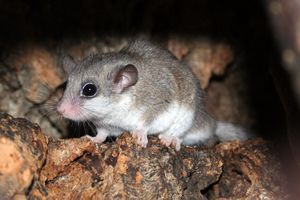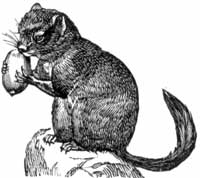زغبة
| Dormice | |
|---|---|

| |
| African dormouse, Graphiurus sp. | |
| التصنيف العلمي | |
| مملكة: | |
| Phylum: | |
| Class: | |
| Order: | |
| Suborder: | |
| Family: | Gliridae Muirhead in Brewster, 1819
|
| Subfamilies and genera | |
الزغبة dormouse هي قارض من فصيلة Gliridae (this family is also variously called Myoxidae or Muscardinidae by different taxonomists). Dormice are mostly found in Europe, although some live in Africa and Asia. They are particularly known for their long periods of hibernation. Because only one species of dormouse is native to the British Isles, in everyday English usage, "dormouse" can refer either to that one species (the hazel dormouse) or to the family as a whole.
السمات
Dormice are small rodents, with body lengths between 6 و 19 cm (2.4 و 7.5 in), and weights between 15 و 180 g (0.53 و 6.35 oz).[بحاجة لمصدر] They are generally mouse-like in appearance, but with furred, rather than scaly tails. They are largely but not exclusively arboreal, agile, and well adapted to climbing. Most species are nocturnal. Dormice have an excellent sense of hearing, and signal each other with a variety of vocalisations.[1]
Dormice are omnivorous, typically feeding on fruits, berries, flowers, nuts, and insects. They are unique among rodents in that they lack a cecum, a part of the gut used in other species to ferment vegetable matter. Their dental formula is similar to that of squirrels, although they often lack premolars:
| تسنين |
|---|
| 1.0.0–1.3 |
| 1.0.0–1.3 |
Dormice breed once or occasionally twice a year, producing litters with an average of four young after a gestation period of 22–24 days. They can live for as long as five years. The young are born hairless and helpless, and their eyes do not open until about 18 days after birth. They typically become sexually mature after the end of their first hibernation. Dormice live in small family groups, with home ranges that vary widely between species, and depend on the availability of food.[1]
البيات الشتوي
One of the most notable characteristics of those dormice that live in temperate zones is hibernation.
Relationship with humans
The edible dormouse was considered a delicacy in ancient Rome, either as a savoury appetizer or as a dessert (dipped in honey and poppy seeds). The Romans used a special kind of enclosure, a glirarium, to rear dormice for the table.[1] Dormice to this day are hunted and eaten in Slovenia. It is also considered a delicacy in several places in Croatia, namely Lika, and islands of Hvar and Brač.[2][3] Dormouse fat was used by the Elizabethans to induce sleep.[4]
التبويب
The family consists of 29 living species, in three subfamilies and (arguably) 9 genera:
FAMILY GLIRIDAE – الزغبة
- Subfamily Graphiurinae
- Genus Graphiurus, African dormice
- Angolan African dormouse, Graphiurus angolensis
- Christy's dormouse, Graphiurus christyi
- Jentink's dormouse, Graphiurus crassicaudatus
- Johnston's African dormouse, Graphiurus johnstoni
- Kellen's dormouse, Graphiurus kelleni
- Lorrain dormouse, Graphiurus lorraineus
- Small-eared dormouse, Graphiurus microtis
- Monard's dormouse, Graphiurus monardi
- Woodland dormouse, Graphiurus murinus
- Nagtglas's African dormouse, Graphiurus nagtglasii
- Spectacled dormouse, Graphiurus ocularis
- Rock dormouse, Graphiurus platyops
- Stone dormouse, Graphiurus rupicola
- Silent dormouse, Graphiurus surdus
- Graphiurus walterverheyeni [5]
- Genus Graphiurus, African dormice
- Subfamily Leithiinae
- Genus Chaetocauda
- Chinese dormouse, Chaetocauda sichuanensis
- Genus Dryomys
- Woolly dormouse, Dryomys laniger
- Balochistan Forest dormouse, Dryomys niethammeri
- Forest dormouse, Dryomys nitedula
- Genus Eliomys, garden dormice
- Asian garden dormouse, Eliomys melanurus
- Maghreb garden dormouse, Eliomys munbyanus
- Garden dormouse, Eliomys quercinus
- Genus Hypnomys† (Balearic dormouse)
- Majorcan giant dormouse, Hypnomys morphaeus†
- Minorcan giant dormouse, Hypnomys mahonensis†
- Genus Muscardinus
- Hazel dormouse, Muscardinus avellanarius
- Genus Myomimus, mouse-tailed dormice
- Masked mouse-tailed dormouse, Myomimus personatus
- Roach's mouse-tailed dormouse, Myomimus roachi
- Setzer's mouse-tailed dormouse, Myomimus setzeri
- Genus Selevinia
- Desert dormouse, Selevinia betpakdalaensis
- Genus Chaetocauda
- Subfamily Glirinae
- Genus Glirulus
- Japanese dormouse, Glirulus japonicus
- Genus Glis
- Edible dormouse, Glis glis
- Genus Glirulus
أنواع أحفورية
- Subfamily Bransatoglirinae
- Genus Oligodyromys
- Genus Bransatoglis
- Bransatoglis adroveri Majorca, Early Oligocene
- Bransatoglis planus Eurasia, Early Oligocene
الهامش
- ^ أ ب ت Baudoin, Claude (1984). Macdonald, D. (ed.). The Encyclopedia of Mammals. New York: Facts on File. pp. 678–680. ISBN 0-87196-871-1.
- ^ Freedman, Paul. "Meals that Time Forgot", gourmet.com, March 2008.
- ^ "Fifth Puhijada". otok-hvar.com
- ^ "10 ways to get a really good sleep", BBC News Magazine, 27 March 2009.
- ^ Holden, Mary Ellen and Levine, Rebecca S (2009). "Chapter 9. Systematic Revision of Sub-Saharan African Dormice (Rodentia: Gliridae: Graphiurus) Part II: Description of a New Species of Graphiurus from the Central Congo Basin, Including Morphological and Ecological Niche Comparisons with G. crassicaudatus and G. lorraineus". Bulletin of the American Museum of Natural History. 331: 314–355. doi:10.1206/582-9.1.
{{cite journal}}: CS1 maint: multiple names: authors list (link)
للاستزادة
- Holden, M. E. "Family Gliridae". pp. 819–841 in Mammal Species of the World a Taxonomic and Geographic Reference. D. E. Wilson and D. M. Reeder, eds. Johns Hopkins University Press, Baltimore, 2005.
وصلات خارجية
- "Dormouse" at BBC Wales Nature
- Glirarium.org (إنگليزية) (بالألمانية)
- Fauna of Europe: Glis glis
- Dormice at The PiedPiper
- Dormice at The Dedicated Dormouse Site
